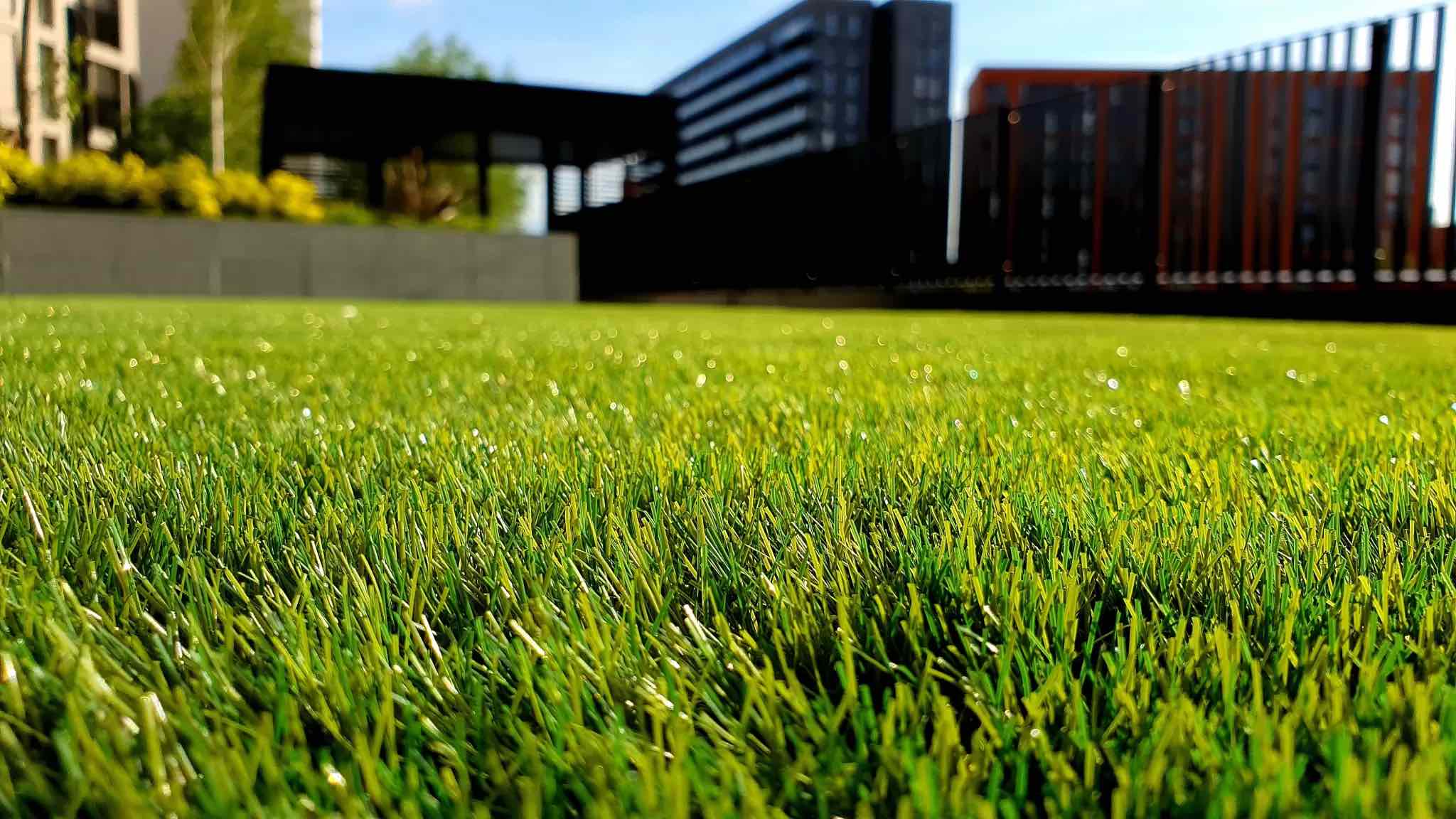WHAT IS THE BEST GRASS FERTILIZER?
There are different types of grass fertilizers, and it is important to know the best one for the type of grass you have and where you live. Here, we will discuss grass fertilization and how to choose a proper grass fertilizer.
GRASS FERTILIZER 101
Soil needs specific nutrients to survive – essential nutrients that deplete over time if not carefully cultivated. Lawn fertilization restores the nutrients your lawn needs to look its best. Here’s how grass fertilizers work:
Components of Fertilizer for Grass
There are three main nutrients listed on every package of lawn fertilizer, always in the same order - nitrogen, phosphorous, and potassium (N-P-K). They are known as the ratio indicating the percentage of each nutrient contained in the bag. A product labeled with 30-0-4 contains 30% nitrogen, 0% phosphorus, and 4% potassium.
- Nitrogen encourages chlorophyll production, which helps with healthy leaf growth.
- Phosphorus helps establish growth below ground level and is important for root growth, water efficiency, and seed formation.
- Potassium enhances growth by regulating root and top growth and keeping grass healthy.
Types of Grass Fertilizers
Every fertilizer is different, and it is essential to choose the right one. Organic fertilizers contain a lot of organic matter, and their chemical makeup is created naturally, while synthetic fertilizers are mass-produced and with precisely calibrated formulas. You'll also see slow-release and quick-release lawn fertilizers on store shelves.
The nutrients in both types are the same, but they’re derived and delivered differently. Slow-release fertilizers are made from natural materials, while quick-release types are made from manufactured, synthetic nutrients.
Learn more about pre-emergent weed killers and herbicides, and how long fertilizers take to work to determine the best fertilizer for your lawn.
CHOOSING A FERTILIZER FOR GRASS
Don't just choose the first grass fertilizer that pops off the shelf. Your fertilizer’s nutrient profile needs to support your lawn’s health – but before you can do that, you’ll need a soil test and to determine your grass type. Soil testing ensures you don't damage your grass or soil makeup and will help you choose the best grass fertilizer for your lawn.
BEST FERTILIZERS BY GRASS TYPE
Before you decide on a grass fertilizer, determine your grass type. Use the guidelines below to help you identify the type of grass in your lawn.
Warm-Season Grasses:
Bermuda grass is usually found in warm climates such as Texas, Florida, and Georgia. Balanced fertilizers high in nitrogen, such as 10-10-10 or 13-13-13 ratio are best.
Zoysia Grass needs a slow-release fertilizer that supports steady growth, especially in areas like South Carolina and Tennessee. Fertilizers with essential micronutrients like iron, manganese, and zinc are a good choice, as are fertilizers with a balanced NPK ratio such as 16-4-8 or 10-10-10 ratio are good.
Cool-Season Grasses:
Kentucky Bluegrass needs fertilizers rich in nitrogen and potassium for lawns in states like Kentucky, Michigan, and Iowa. Use a slow-release with a 3-1-2 ratio.
Fescue Grass needs fertilizer to enhance root growth and stress tolerance, especially in regions like North Carolina and Indiana. A slow-release formula with a 3-1-2 ratio is best.
Transition Zone Grasses:
Tall Fescue & Ryegrass: In transition zones like Oklahoma and Kansas, it is best to use a high-nitrogen, low-phosphorus type of fertilizer.

SEASONAL FERTILIZER RECOMMENDATIONS
Grass Fertilizer for Spring
Early-season fertilization is best to jumpstart the growth of grass for springtime. It's best to apply between late winter and early spring when the grass is beginning to grow actively.
- Colorado & North Dakota: In these states, cool-season grass needs nitrogen-rich fertilizer. Begin applying in early spring.
- Texas & Florida: These warm-season grasses need slow-release fertilizers to gradually provide nutrients as temperatures rise.
Grass Fertilizer for Summer
In the summer, balanced fertilizers that protect against heat stress are needed.
In states like Georgia and South Carolina, fertilizers that help grass endure heat and drought conditions are essential. Use a slow-release fertilizer with high nitrogen and potassium, and a ratio of 20-0-10.
In Michigan and Indiana, light fertilization is needed to maintain growth without over-stimulating during summer heat. Try a slow-release fertilizer.
Grass Fertilizer for Fall
Applying fertilizer to prepare grass for winter is important so that the lawn has the nutrients needed to get through the cold weather.
In areas such as New Jersey and Kentucky, use high-potassium fertilizers to enhance root development before winter, such as a 10-0-20.
States such as Nebraska and Oklahoma have cool-season grasses in the fall. Ensure spring growth with a formula of 20-8-8 or 24-0-12.
Grass Fertilizer for Winter
In the colder months, fertilization is generally not needed, however, there are exceptions.
States like Florida and Texas have mild winters. Use a light fertilizer, such as a nitrogen-rich type to maintain grass health.
REGIONAL GRASS FERTILIZER TIPS
Different areas of the region have different fertilizer needs, so you'll need to choose accordingly. The tips below are based on standard regional and are not official recommendations. For the most accurate and effective plan, contact your local Heroes Lawn Care to determine your grass type and get your soil tested.
- In Colorado, water management is important. You will need a fertilizer rich in nitrogen and phosphorus.
- In Florida, use a nitrogen-rich fertilizer designed for sandy soils and frequent rain like a slow-release type.
- In Georgia, balanced fertilizers work well and support both warm- and cool-season grasses. Try a ratio such as 10-10-10.
- Indiana is known for a mix of cool-season grasses, so a fertilizer with nitrogen and phosphorus and a ratio of 10-10-10 is needed.
- Those in Iowa need nitrogen-rich, fertile soils, for cool-season grasses.
- In Kansas, use a fertilizer that supports grasses in a continental climate with hot summers and cold winters. Try a ratio of 30-0-0 or 29-5-4.
- Kentucky needs fertilizers that cater to cool-season grasses in a humid subtropical climate. Apply a 12-4-8 ration with a slow-release form of nitrogen.
- Michigan lawns need a fertilizer rich in potassium.
- In Nebraska, the best time to fertilize is late April to early May. Fertilize again in late May, then early September, and finally in late October. Be sure to use a 50% quick-release N and 50% slow-release or controlled-release N.
- New Jersey lawns need nitrogen-rich fertilizers that support both cool-season grasses and diverse soil types in a humid climate.
- In North Carolina, use fertilizers that work well in a transition zone climate. Warm- and cool-season grasses need a slow-release fertilizer.
- North Dakota is an area with cool-season grass growth in a climate with cold winters and warm summers. Use a nitrogen-rich fertilizer with 5 to 10 percent potash.
- In Oklahoma, use fertilizers that support warm-season grasses in a continental climate. Fertilize in the summer with slow-release nitrogen fertilizer containing a ratio of 3:1:2 or 4:1:2.
- South Carolina has warm-season grasses in a humid subtropical climate, so use a nitrogen-rich fertilizer.
- In Tennessee, use a balanced fertilizer for transition zone grasses in the fall and spring.
- In North Texas and South Texas, use a slow-release fertilizer with a ratio of 3-1-2 or 4-1-2 to support warm-season grasses in diverse climates.
FAQS ABOUT GRASS FERTILIZERS
HOW OFTEN SHOULD I FERTILIZE MY LAWN?
Depending on the soil, grass type, and regional climate, you should fertilize your grass about four times per year. This also depends on whether you choose a quick-release or slow-release, synthetic or organic fertilizer for grass. Speak with a skilled lawn care technician to determine your grass fertilization schedule.
CAN I USE THE SAME FERTILIZER YEAR-ROUND?
No. Different seasons and conditions require different fertilizers and need to be adjusted according to climate conditions.
WHAT ARE THE SIGNS MY LAWN NEEDS FERTILIZER?
When you see that the grass is turning yellow, or notice slow growth, and thinning patches, your lawn needs to be fertilized.
IS ORGANIC FERTILIZER BETTER FOR MY LAWN?
Organic fertilizers may be preferred over synthetic options. This type is better for water movement and the structure of the soil, and also for providing more micronutrients that grass needs.
WHAT IS THE BEST FERTILIZER FOR NEW GRASS SEED?
The best fertilizer for new grass seed is typically a starter fertilizer specifically formulated to help young grass seedlings establish strong roots and grow healthy. Starter fertilizers often have a higher phosphorus content, which is essential for root development. Look for a fertilizer with a balanced ratio, such as 10-20-10 (N-P-K), where the middle number (phosphorus) is higher than the others. Learn more about what fertilizer does for grass.
THE ROOT OF IT: THERE'S NO ONE BEST GRASS FERTILIZER
Grass fertilizer is not a one-type-fits-all solution for your lawn. Depending on the type of grass you have and your region, a blend of different fertilizer types may be necessary, especially during changing seasons.
Conduct soil tests and consider the regional climate when choosing a grass fertilizer to give your lawn exactly what it needs to look its best year-round. Or, find a Heroes Lawn Care near you to get the skilled landscaping services your lawn deserves.




